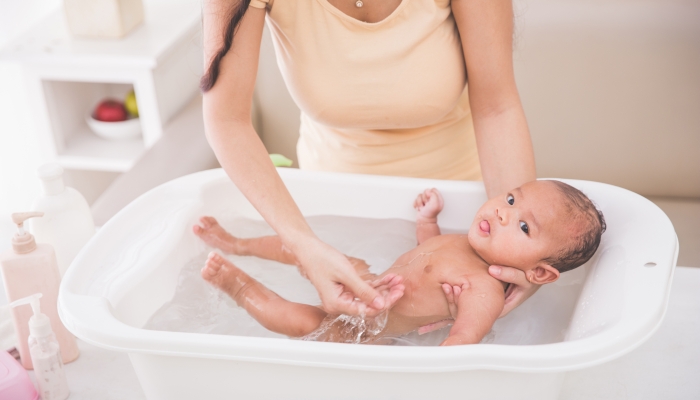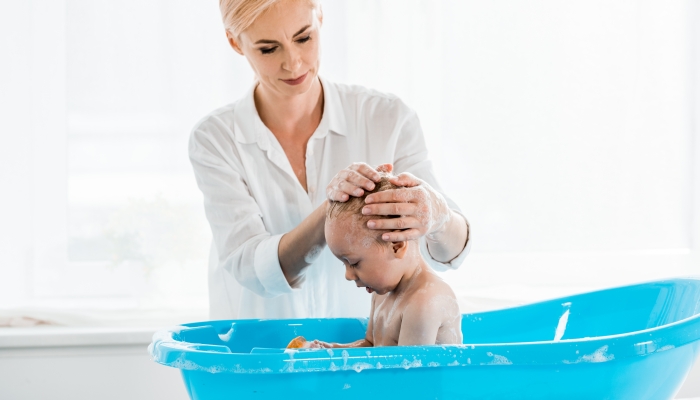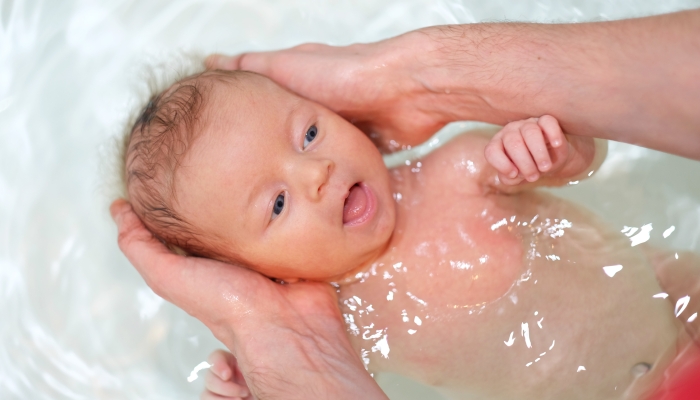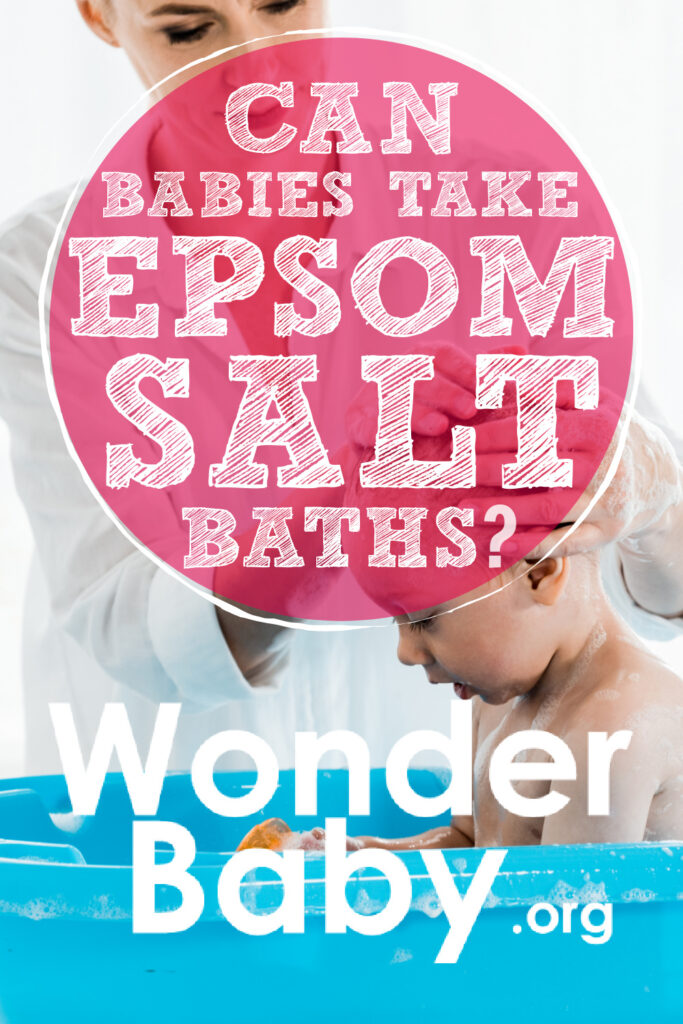Can Babies Take Epsom Salt Baths?

- Epsom salt has a variety of medicinal benefits and healing properties.
- Dehydration and accidental ingestion are potential adverse effects that can occur when using Epsom salt.
- Preparation is important when making an Epsom salt bath for an infant.
Bath time is a favorite activity for many children. It offers an opportunity for sensory integration, self-directed play, and can be a bonding experience for parents and their children. Many parents will tell you that bath time is among their favorite caretaking activities.
What goes in that warm bath water, though, can be a matter of some thought. Many adults are advocates of Epsom salt baths to aid in detoxifying the body, ease minor aches and pains, and achieve a greater state of relaxation. If parents enjoy the many benefits of soaking in a warm Epsom salt bath, it stands to reason that their infants and children might enjoy it too.
Can babies take Epsom salt baths? If you’re thinking of giving your baby an Epsom salt bath, there are some guidelines to follow and precautions that need to be in place first.
Epsom Salt Baths: All You Need to Know
According to the Cleveland Clinic, pure Epsom salts are naturally-occuring mineral compounds long claimed to ease muscle strain and promote relaxation. Though they may look like coarse salt or sugar, they are composed of magnesium and sulfate, as opposed to the sodium and chloride ions that form table salt. Magnesium ions are absorbed into the body through the skin during the Epsom salt bath.
Why is Magnesium Important?
Magnesium is an element that is involved in the regulation of vital body systems, such as muscle and nerve function and blood pressure. According to the National Institutes of Health, infants within the first six months of life need 30 mg of magnesium daily while infants who are 7-12 months require 75 mg.
Research by Bo Lönnerdal, PhD in the study Magnesium nutrition of infants has found that magnesium is present in the necessary daily amounts in breast milk, formula, and cow’s milk. For this reason, additional magnesium supplementation is generally not needed in healthy infants.

Benefits vs Risks of Epsom Salt Baths
Epsom salts have a variety of medicinal benefits and healing properties. Regular use of Epsom salt baths are thought to:
- Repair damaged skin cells.
- Ease skin irritation, itching, and discomfort associated with skin conditions like eczema.
- Encourage the regeneration of healthy cells through gentle exfoliation of dead skin cells.
- Reduce stiff joints, muscle pain, and inflammation.
- Ease tension within the nervous system.
- Promote relaxation and restful sleep.
Though Epsom salt is a relatively neutral chemical compound in and of itself, there are some potential risks to consider.
Dehydration and Electrolyte Disturbances
Occasionally, parents will desire to give their baby a “cleanse” through means of ingesting a solution containing magnesium sulfate. As anyone who has ever done prep for a colonoscopy will tell you, deliberate ingestion of magnesium-containing compounds will induce a violent bowel reaction.
The resulting excessive bowel movements can result in profound dehydration and electrolyte disturbances, especially in infants. Laxatives, or “cleanses” of any sort, should not be given to infants without a healthcare provider’s direction.
Accidental Ingestion
Since babies within the first year of life receive the necessary amount of magnesium through their diets, accidental ingestion of bath water containing Epsom salt can be a serious concern. Overdose symptoms of magnesium include:
- Upset stomach
- Loose bowel movements
- Flushing
- Nausea
- Headache
- Slow heart rate
- Extreme drowsiness
To limit accidental ingestion of water during an Epsom salt bath, never leave your infant unattended while in the bathtub, and limit soak time to 15–20 minutes.
Can Babies Take Epsom Salt Baths?
With proper precautions in place to ensure a safe and pleasurable bath time for your baby, most infants can enjoy an Epsom salt bath.
Infants who have burns, serious open wounds, known calcium or magnesium disorders, or certain heart or blood vessel conditions should not use baths with Epsom salt. Consult your child’s healthcare provider prior to use in these situations.
How to Give your Baby an Epsom Salt Bath
You’ve done your homework and determined that your baby is ready to enjoy their first Epsom salt bath. What can you do to help ensure a positive experience?
Prepare the Water
Fill an infant bathtub or basin with slightly warm water. Hot water is extremely dangerous for infants and can cause scalding burns easily due to their thinner skin. The water doesn’t need to be deep; just a few inches will be enough for your child.
Add The Salt
Pure Epsom salt is recommended for an infant’s bath. Read labels carefully and avoid using products that contain additional dyes or fragrances, as these can irritate a baby’s delicate skin.
The amount of Epsom salt you will add depends on your child’s age and health conditions; generally, 1–2 cups of Epsom salt per standard adult tub is an acceptable range. A smaller tub will necessitate a smaller amount of Epsom salt. Ensure the Epsom salt is fully dissolved in the slightly warm water prior to adding your baby.
Putting the Baby in the Bath Water
Gently introduce your baby into the Epsom salt bath. Observe your child’s reaction carefully: Are they uncomfortable or look uneasy? Do you notice a rash developing? If you note signs of an adverse reaction, immediately remove your baby from the tub and rinse them in fresh, slightly warm water. Contact your child’s healthcare provider for further guidance.

Safety Tips When Giving Your Baby Epsom Salt Baths
When adding Epsom salts to your child’s bath, keep the following safety tips in mind.
DO:
- Keep Epsom salt baths relatively brief. 15-20 minutes is enough for the magnesium sulfate in the water to do its work.
- Stay next to your child during the bath experience to monitor for adverse reactions and ensure safety.
- Observe your child’s skin after the bath for irritation or excessive dryness.
- Add some baby bath toys! Try cleaning bath toys after the bath in order to prevent mineral build up.
AVOID:
- Bathing with or without Epsom salt too often. Excessive frequency of bathing with Epsom salt and/or adding too much to the water can result in adverse effects from the magnesium and sulfate ions.
- Letting your child swallow water containing Epsom salt. If it does happen, try not to panic. Remove them from the bath and wipe the inside of their mouth with a soft cloth rinsed in clean water. Do not try to induce vomiting in an infant.
FAQs
What does the research say about Epsom salt baths for babies?
Research isn’t clear on the use of Epsom salt in an infant’s bath. Anecdotal evidence widely supports the safety and benefits of Epsom salt use through transdermal absorption. There is a lack of evidence from clinical trials supporting or disputing these claims.
Can I add baking soda to my baby’s Epsom salt bath?
Many adults will add baking soda to their own Epsom salt baths, as baking soda is thought to have cleansing and detoxifying properties and will aid in boosting immunity.
The use of baking soda in an infant’s bath is mixed. Some sources claim it is an effective treatment for diaper rash and other skin ailments. Others state that the alkaline nature of baking soda changes the natural ㏗ of the baby’s skin, leading to cracks, excessive dryness, and irritation.
If you decide to add baking soda to your baby’s Epsom salt bath, try 1–2 tablespoons and avoid using it too frequently.
Can I add essential oils to an Epsom salt bath?
Essential oils are also added at times to enhance the sensory experience of soaking in a tub and deepen relaxation. With correct use, essential oils can also help regenerate healthy skin cells, reduce inflammation, and relieve itchiness.
Note: Dilution of essential oils is necessary prior to using on an infant. Not all essential oils are appropriate for children, and some are harmful if accidentally swallowed. Consult your healthcare provider prior to using essential oils with your baby.
How much magnesium is my child absorbing through the bath water?
There are many variables to consider: size of the tub, amount of Epsom salt added, amount of water, and frequency of bathing, to name a few.
Because all of these elements are fluid, there is no way to consistently determine how much of the magnesium and sulfate ions your baby is absorbing through their skin. Thus, it is important to stay with your child during the bathing experience and monitor closely for adverse reactions.
Can I use soap on my baby after an Epsom salt bath?
There’s no need. Though the usual practice during a bath is to wash an infant, using soap after an Epsom salt bath can overdry the skin. Tiny cracks can form on the skin’s surface that may allow the magnesium and sulfate ions, as well as bacteria, to enter deeper into the skin and cause adverse effects.
Though there is a lack of data from clinical trials, the lived experience of many infants suggests that they do enjoy a soak in Epsom salt water and reap a variety of health benefits. Armed with a few safety precautions and new information, you too can offer the soothing and healing benefits of an Epsom salt bath to a favorite infant in your life!

The information WonderBaby provides is not intended to be, and does not constitute, medical or other health advice or diagnosis and should not be used as such. Always consult with a qualified medical professional about your specific circumstances.
Related Posts

Eye Conditions and Syndromes, Visual Impairment
Neuralink Announces Plans to Restore Sight to the Blind with Brain Chip
Elon Musk’s company Neuralink has announced plans to begin human trials of its new “Blindsight” brain chip by the end of 2025.

Health & Nutrition
Can Baby Skin Care Products Expire?
Is that forgotten tube of diaper rash cream still safe to use? Learn more about the expiration dates of popular skin care products for infants.

Health & Nutrition
Boosting Immunity in Kids: 3 Tips for a Healthy Winter
Parents can help boost their kids’ immunity during cold and flu season by maintaining healthy eating, sleeping, and exercising habits in the winter.